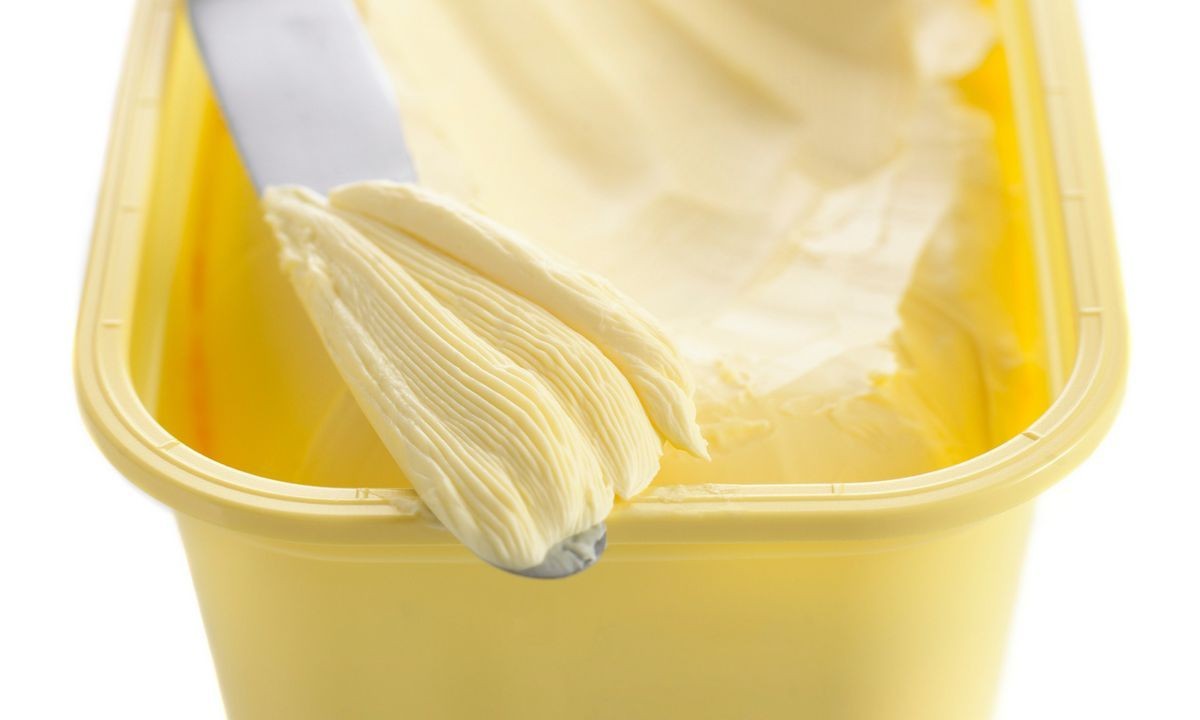
Contents
What Is Margarine? How Is It Different From Butter?
Margarine is a type of spread marketed as a healthier butter substitute. It is made of plant-based fats and other ingredients.
Not many people know the composition and health effects of margarine, despite its growing popularity. So, let’s explore what margarine is made of and whether it is beneficial for human health.
Margarine and butter both have their pros and cons. They have similar uses in baking and cooking but different ingredients. Because their nutrient profiles vary, they can affect the body differently depending on dietary needs and genetics. So, instead of focusing on which is healthier, choose the one that suits your needs best.
Read on to learn more.
Margarine is a spread made by emulsifying a water-in-oil mixture. It can be derived from animal fats or plant-based fats. Vegetable oils like soybean oil, palm oil, cottonseed oil, and canola oil have gained popularity due to the rise of vegan diets.
Most types of margarine contain salt, vitamins, colorants, emulsifiers, thickeners, and flavorings to mimic the nutritional value, taste, and texture of butter. However, there are also unprocessed varieties available if that is your preference.
The term "margarine" is often used generically for any butter substitute, including low-fat spreads. However, the FDA recognizes a product as margarine only if it contains 80% or more edible fat, water, vitamin A, and good edible protein of either plant or animal origin.
You can find different forms of margarine in the market, such as stick margarine, light margarine, liquid margarine, and soft margarine available in tubs. Margarine has become a staple in many diets worldwide due to its flavor, price, spreadability, and convenience.
How is margarine made?
Plant-based oils cannot be used in their natural form because they remain liquid at room temperature. To mimic the texture of butter, food scientists initially used hydrogenation, a process that converts unsaturated fats into solid, saturated fats. However, this method also produces trans fats, which are known to be unhealthy.
To reduce trans fat consumption, margarine manufacturers have shifted to interesterification, a process that hardens vegetable oils without producing trans fats. Margarine made using this method is generally considered healthier.
What are the nutrients in margarine?
Margarine is a source of essential vitamins and fatty acids. Stick margarine typically contains per tablespoon:
- Calories: 100 grams
- Total fats: 12 grams
- Cholesterol: 0
- Saturated fats: 2 or 3 grams
- Monounsaturated fats: 5 or 6 grams
- Polyunsaturated fats (PUFA): 3 or 4 grams
The fat content can vary depending on the vegetable oil used and the type of margarine. For example, soft margarine and diet margarine-like spreads have higher PUFA content than other forms. Light margarine contains fewer fats and calories than regular stick margarine.
Most margarine products are also fortified with vitamins A, D, and E, as well as omega-3 fatty acids.
How is butter different from margarine?
Butter is concentrated dairy fat produced by churning pasteurized cream.
Butter contains higher amounts of saturated fats and cholesterol compared to margarine. Some manufacturers add salt to the product.
Butter is available in stick and spread form. It is commonly used in baking, cooking, and frying, particularly in pastries, cakes, and sauces.
QUESTION
Margarine vs Butter: Which is healthier?
Margarine and butter have different nutrient profiles with their own advantages and disadvantages. The health impact depends on the specific type and amount consumed.
For example, grass-fed butter contains beneficial nutrients such as vitamin K2, omega-3 fatty acids, and conjugated linoleic acid (CLA) linked to improved health. However, butter also has high amounts of saturated fats and cholesterol, which can pose health risks.
Margarine, on the other hand, generally has fewer saturated fats and cholesterol than butter. It is rich in polyunsaturated fatty acids (PUFA), which can reduce the risk of heart disease. However, margarine may contain potentially unhealthy compounds like omega-6 fatty acids and, in some cases, trans fats.
Choosing between margarine and butter depends on individual dietary needs, genetic tendencies, gender, and health condition. Some reasons to choose margarine include the need for a low-cholesterol or vegan alternative to butter. It’s important to check the ingredients and avoid margarine with partially hydrogenated oils.
Butter can also be a reasonable choice for most people, especially grass-fed varieties. However, moderation is key to enjoy the benefits of both products without excessive fat intake.


